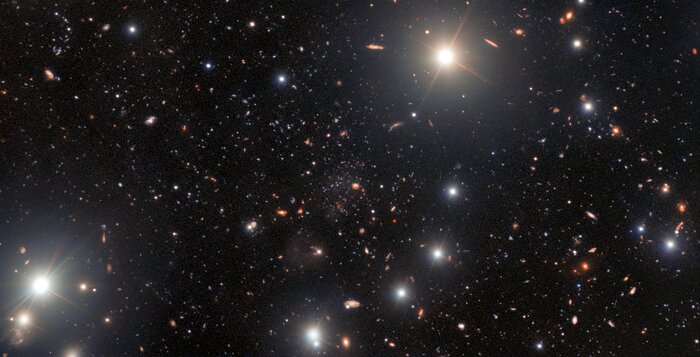The ultra-faint dwarf galaxy Pegasus V
A unique ultra-faint dwarf galaxy has been discovered in the outer fringes of the Andromeda Galaxy thanks to the sharp eyes of an amateur astronomer examining archival data from the US Department of Energy-fabricated Dark Energy Camera on the Víctor M. Blanco 4-meter Telescope at Cerro Tololo Inter-American Observatory (CTIO) and processed by the Community Science and Data Center (CSDC). Follow-up by professional astronomers using the International Gemini Observatory revealed that the dwarf galaxy — Pegasus V — contains very few heavier elements and is likely to be a fossil of the first galaxies. All three facilities involved are Programs of NSF's NOIRLab.
Credit:International Gemini Observatory/NOIRLab/NSF/AURA
Acknowledgment: Image processing: T.A. Rector (University of Alaska Anchorage/NSF’s NOIRLab), M. Zamani (NSF’s NOIRLab) & D. de Martin (NSF’s NOIRLab)
About the Image
| Id: | noirlab2214a |
| Type: | Observation |
| Release date: | June 30, 2022, 8 a.m. |
| Related releases: | noirlab2214 |
| Size: | 1992 x 1015 px |
About the Object
| Name: | Andromeda Galaxy |
| Constellation: | Pegasus |
| Category: | Galaxies |
Wallpapers
Coordinates
| Position (RA): | 23 18 27.89 |
| Position (Dec): | 33° 21' 35.61" |
| Field of view: | 5.37 x 2.73 arcminutes |
| Orientation: | North is 89.9° right of vertical |
Colors & filters
| Band | Wave-length | Tele-scope |
|---|---|---|
| Optical g | 475 nm | Gemini North GMOS-N |
| Optical g | 475 nm | Gemini North GMOS-N |
| Optical r | 630 nm | Gemini North GMOS-N |
| Optical r | 630 nm | Gemini North GMOS-N |

